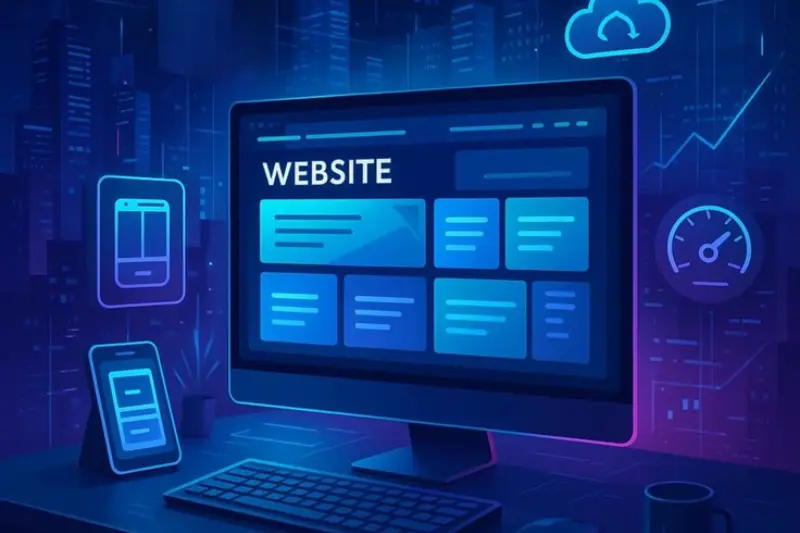In today’s digital world, a website is more than just an online presence — it’s your identity, brand, and first impression for anyone searching for you or your business. Whether you want to start a blog, promote your services, or sell products online, having a website opens the door to countless opportunities.
In this article, we’ll share a step by step guide to create a website that is beginner-friendly, easy to follow, and practical. By the end, you’ll know exactly how to plan, design, launch, and maintain your own website without feeling overwhelmed.
Step 1: Define Your Purpose and Goals
Before you start building, take a moment to decide why you want a website. Having a clear purpose makes the whole process easier and helps you choose the right design, tools, and features.

Common Website Purposes:
- Personal Blog – Share your thoughts, experiences, or hobbies.
- Portfolio – Showcase your work, skills, or creative projects.
- Business Website – Promote your company, services, or brand.
- E-commerce Store – Sell products or digital items online.
- Educational/Informational Site – Share tutorials, guides, or resources.
Goal-Setting Tips:
- Write down what you want your site to achieve (e.g., get clients, sell products, grow an audience).
- Decide on your target audience (who you want to visit your site).
- Think about long-term plans—will it stay simple, or do you want to expand later?
A clear purpose saves time, money, and effort by guiding every decision you make while creating your website.
Step 2: Choose a Domain Name
Your domain name is your website’s online address (like www.yoursite.com). It’s the first thing visitors will see, so make sure it’s easy to remember and reflects your purpose.
Tips for a Strong and Memorable Domain Name:
- Keep it short and simple – Easy to type and remember.
- Use keywords – If possible, include words related to your niche or business (e.g., “fitnesshub.com” for a fitness blog).
- Avoid numbers and hyphens – They make names harder to remember.
- Check availability – Use domain registrars like GoDaddy, Namecheap, or Google Domains.
- Choose the right extension –
.comis most popular, but you can also use.net,.org, or niche-specific ones like.storeor.blog.
Example: If you’re creating a portfolio, instead of johnsmith123-site.com, go for something cleaner like johnsmithdesign.com.
A good domain name makes your site look professional and easy for visitors to find.
Step 3: Select a Hosting Provider
A hosting provider is where your website files are stored so people can access them online. Think of it as renting space on the internet.
Types of Hosting:
- Shared Hosting – Budget-friendly, good for beginners and small websites.
- VPS Hosting – Offers more speed and control, ideal for growing websites.
- Cloud Hosting – Reliable, scalable, and great for websites expecting traffic growth.
- Dedicated Hosting – Best for large businesses, but more expensive.
For beginners, Shared Hosting (like Bluehost, Hostinger, or SiteGround) is usually the best option.
Step 4: Pick a Website Building Platform
Once you have hosting, you need a platform to build your website.
Popular Options:
- WordPress.org – Flexible, customizable, and perfect for blogs, business sites, and e-commerce.
- Wix / Squarespace – Drag-and-drop builders, no coding required, beginner-friendly.
- Shopify – Best for creating online stores.
- Custom Coding – For advanced users who want complete control.
For most beginners, WordPress.org is the most recommended option due to its flexibility and thousands of plugins.
Step 5: Design Your Website
A professional design makes your website attractive and easy to use.
Key Design Tips:
- Choose a clean layout with simple navigation.
- Pick colors and fonts that match your brand style.
- Use mobile-friendly themes since most visitors browse on phones.
- Add essential pages like Home, About, Services/Products, Blog, and Contact.
Step 6: Add Essential Features
Your website should not only look good but also function well.
Must-Have Features:
- SEO tools (Yoast SEO, Rank Math) to improve Google ranking.
- Security features like SSL certificates, backups, and firewalls.
- Contact forms and email signups to connect with visitors.
- Social media integration for better sharing and engagement.
- Speed optimization through image compression and caching.
Step 7: Publish and Promote
After your website is ready, publish it and start promoting.
Promotion Tips:
- Share it on social media platforms.
- Start a blog with SEO-friendly posts to bring in organic traffic.
- Use email marketing to reach your audience directly.
- Run paid ads if you want faster visibility.
Step by step guide to create a website Pro Tips
Creating a website is easier when you follow some smart practices from the start. Step by step guide to create a website These tips will help you avoid issues and make your site more effective.
- Always back up your site – Regular backups protect you in case something goes wrong.
- Keep everything updated – Update themes, plugins, and software to maintain security.
- Focus on user-friendly design – Simple navigation, clear content, and fast loading make visitors stay longer.
- Use high-quality images – Blurry or oversized images slow down your site and look unprofessional.
- Test your site on mobile – Most people browse on phones, so check that your site works smoothly on smaller screens.
You may also like to read these posts:
Collaboration Tools for Remote Teams: A Complete Guide
Email Marketing Tools Comparison: Best Picks 2025
Best Free Online Software for Small Businesses 2025
Best Collaboration Tools for Remote Teams-Boost Productivity
Common Mistakes to Avoid
Many beginners make small mistakes that can affect the success of their website. Step by step guide to create a website Being aware of these will save you time and effort.

- Choosing a complicated domain name – Long or confusing names are hard for visitors to remember.
- Ignoring mobile optimization – If your site doesn’t work well on phones, you’ll lose a large part of your audience.
- Poor planning of content – Without a clear structure, your website may look messy and unprofessional.
- Overloading with plugins or features – Too many add-ons can slow down your site.
- Skipping SEO setup – Not focusing on search engine optimization makes it harder for people to find your site.
FAQs About Creating a Website
Can I create a website for free?
Yes, platforms like WordPress.com, Wix, and Blogger offer free plans, but they come with limitations. For a professional site, it’s better to use paid hosting and a custom domain.
How long does it take to build a website?
A simple website can be set up in a few hours. However, a fully customized site with advanced features may take several days or weeks.
Do I need coding skills to create a website?
No, most website builders and WordPress themes let you design a site without coding. Coding is only needed if you want full customization.
How much does it cost to make a website?
On average, you’ll spend between $50–$200 per year for domain and hosting. Extra costs may include premium themes, plugins, or e-commerce tools.
Which platform is best for beginners?
WordPress.org is the most flexible option, while Wix and Squarespace are the easiest for beginners who prefer drag-and-drop design.
Conclusion
Step by step guide to create a website may seem difficult at first, but when you follow a clear step by step process, it becomes simple. From choosing your domain name and hosting to designing, adding features, and promoting, every step plays an important role in your online success.
By using this step by step guide to create a website, beginners can easily launch their site without confusion. Whether your goal is blogging, starting an online store, or building a professional brand, Step by step guide to create a website your website will help you connect with people and grow your presence online.
Start today with a clear plan, and your website will soon become a powerful tool for your personal or business growth.





